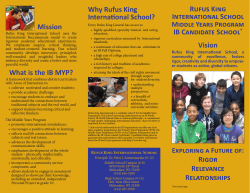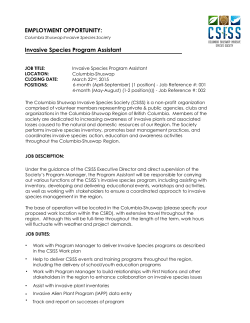
A. vulgaris
GLOBAL CHANGE AND GENETIC IMPACT OF INVASIVE SPECIES The case of invasive and native Arion slugs in Switzerland Miriam Zemanovaa,b, Eva Knopb, Gerald Heckela,c a Computational and Molecular Population Genetics (CMPG), Institute of Ecology and Evolution, University of Bern, Baltzerstrasse 6, CH-3012 Bern b Community Ecology, Institute of Ecology and Evolution, University of Bern, Baltzerstrasse 6, CH-3012 Bern c Swiss Institute of Bioinformatics, Genopode, CH-1015 Lausanne miriam.zemanova@iee.unibe.ch Background and rationale Research questions CLIMATE CHANGE AND INVASIVE SPECIES The Swiss native slug A. rufus used to be widely distributed, but is now confined to natural habitats, mainly at higher altitudes, to where A. vulgaris is spreading. climate change and invasive species represent two of the greatest threats to biodiversity and the provision of valuable ecosystem services combined, the complexity of the interaction of these two global drivers increases dramatically climate change impacts are likely to facilitate the introduction, establishment and spread of invasive species Arion vulgaris and A. rufus are difficult to distinguish based on their external morphology. There have been some reports of intermediate morphological forms, suggesting that hybridization might occur. IS THE DECLINE OF NATIVE A. RUFUS LINKED TO THE SPREAD OF INVASIVE A. VULGARIS? DOES THIS INVOLVE INTROGRESSIVE HYBRIDIZATION? IMPACT OF INVASIVE SPECIES Materials and methods Sampling sites for Blumenstein (B), Salvan (S) and Filfalle (F) transects. Pie charts represent average assignment probability of belonging to each of two genetic clusters identified by STRUCTURE based on microsatellite allele frequencies. Individual membership coefficients are displayed in the bar plots: each individual is represented by a single horizontal bar, with sampling locality labels shown on the right. Sampling localities are separated by a black line. The genetic cluster representing A. vulgaris is shown in red, A. rufus in blue. The patterns suggest the presence of a zone of genetic admixture at intermediate altitudes. Filfalle shows signs of more extensive admixture between the invasive and the native Arion species. sampling along three altitudinal transects over 600 Arion sp. individuals genotyped with 15 microsatellite markers Bayesian admixture analysis Arion vulgaris is present in the lowlands and is spreading into the mountains. Results and conclusions A. vulgaris is predominant in the lowlands, A. rufus is mainly at higher altitudes SPANISH SLUG (ARION VULGARIS) we provide evidence of various degrees of admixture between the two species at locations of contact belongs to one of the 100 most invasive species in Europe causes large economic costs in agriculture hybridization might be indeed involved in the displacement of A. rufus introduced to Switzerland in 1955 its impact on native fauna is still unclear: populations of closely related species decline when A. vulgaris is introduced to the region Top: distribution of A. vulgaris in Switzerland in 1955, 1985 and 2015. Right: sampling locations along altitudinal transects in Blumenstein, Salvan and Filfalle. This project has been funded by the Federal Office for the Environment (BAFU) and the University of Bern. without specific conservation action, A. vulgaris will probably further expand its range, which is likely to be assisted by global change impacts
© Copyright 2025










